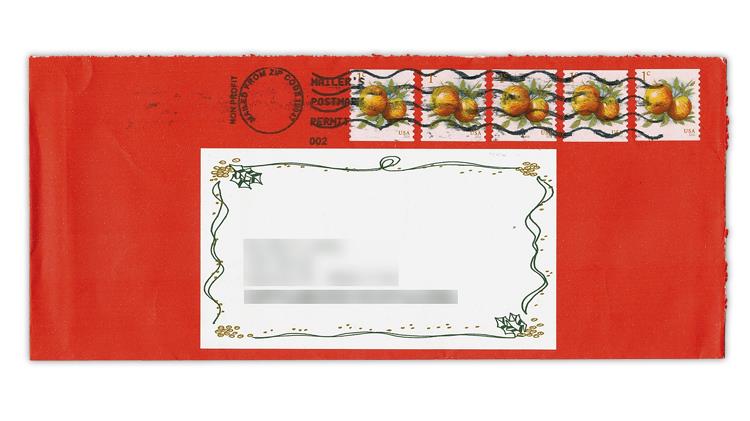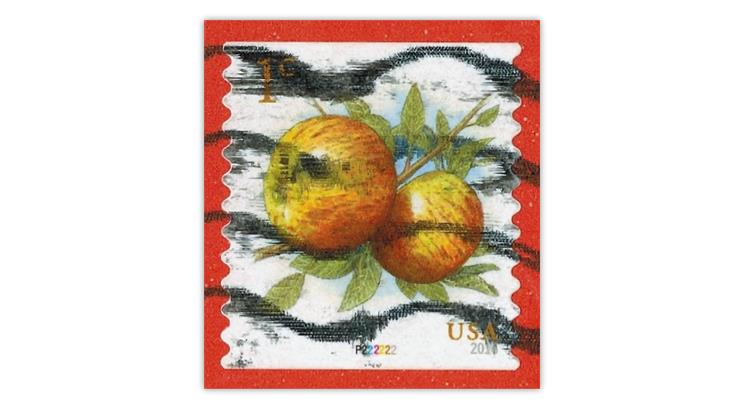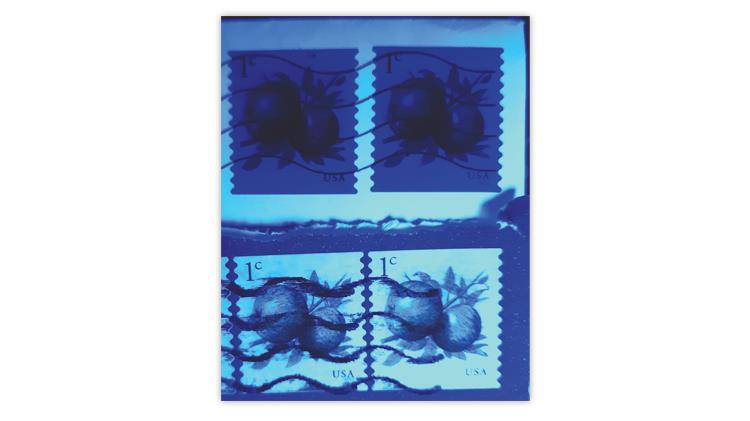US Stamps
Second plate number discovered for U.S. 2016 1¢ Apples coil
By Ronald Blanks
A new plate number for an existing United States coil issue surfaced on mail received during the week after Thanksgiving.
Jim Fowler found a 2016 1¢ Apples coil stamp (Scott 5037) bearing plate number P222222 on a mailing from the nonprofit organization Covenant House.
On Nov. 30, Fowler, a member of the Plate Number Coil Collectors Club, received the cover pictured in Figure 1.
Five 1¢ Apples coil stamps were machine-affixed to the red envelope from a large roll, with the third stamp from the left showing the new plate number. A close-up of the stamp with the plate number is shown in Figure 2.
Prior to the discovery, the 1¢ Apples coil stamp was known only with plate number P111111. The stamp was issued in rolls of 3,000 and 10,000 on Aug. 12, 2016. The plate number’s P prefix stands for the printer, Ashton-Potter (USA) Ltd.
Under current U.S. Postal Service stamp-issuing policy, printers change plate numbers when a change is made to a stamp’s production. Such change has usually been switching the paper provider or revising how phosphor tagging is applied (for stamps denominated 10¢ or more).
Postal Service spokesman Jim McKean told Linn’s Stamp News that a change in paper for the 1¢ Apples coil stamp printed in rolls of 10,000 led to the new P222222 number. There has been no such change to the 1¢ Apples coil stamp printed in rolls of 3,000, according to McKean.
Meanwhile, I happened to find another example of the Covenant House red envelope mailing at my local post office on Dec. 3. This provided an opportunity for closer examination.
The 1¢ Apples coil stamps on the Covenant House envelope I received were compared to 1¢ Apples coil stamps on an unrelated mailing from May 2020 on white envelopes. Cropped images of both envelopes are shown under longwave ultraviolet light in Figure 3. The older stamps from the 2020 mailing, top, show no reaction while the new stamps from the recent Covenant House mailing, bottom, glow brightly.
This glow, also evident under shortwave ultraviolet light, is due to optical brighteners added to the stamp paper. The brighteners are commonly found in white envelope paper. Tiny specks of brighteners are visible around the coil stamps at bottom in Figure 3.
The mailers of the Figure 1 and Figure 3 envelopes canceled the stamps under a mailer’s postmark permit as required by the USPS because they elected not to use a nondenominated (5¢) “nonprofit org” service-inscribed coil stamp the USPS offers to qualified mailers.
The service-inscribed coil stamps are priced at 5¢, the minimum postage to be affixed to nonprofit mailings when the mailer uses stamps, generally for added visual effect.
Actual rates vary for a mailing depending on the mailer’s presorting and bundling efforts that reduce post office work.
Mailers pay computed postage from funds on account, receiving credit for the token 5¢ per mailpiece. As Covenant House did here, 5¢ in ordinary denominated stamps can be used as long as the mailer cancels them.
Ronald Blanks has collected stamps since 1968. He specializes in U.S. postal history of marketing mail and of mechanized postal improvements. He can be reached at rblanks_stamps@yahoo.com or Box 9282, Chesapeake, VA 23321.
Connect with Linn’s Stamp News:
Sign up for our newsletter
Like us on Facebook
Follow us on Twitter
MORE RELATED ARTICLES
Headlines
-
US Stamps
Oct 7, 2024, 12 PMVasiliauskas named president of Mystic Stamp Co.
-
US Stamps
Oct 6, 2024, 5 PMApgar souvenir card available
-
US Stamps
Oct 6, 2024, 4 PMFirst Continental Congress and U.N. stamps receive Scott catalog numbers
-
World Stamps
Oct 5, 2024, 1 PMCanada Post continues Truth and Reconciliation series











